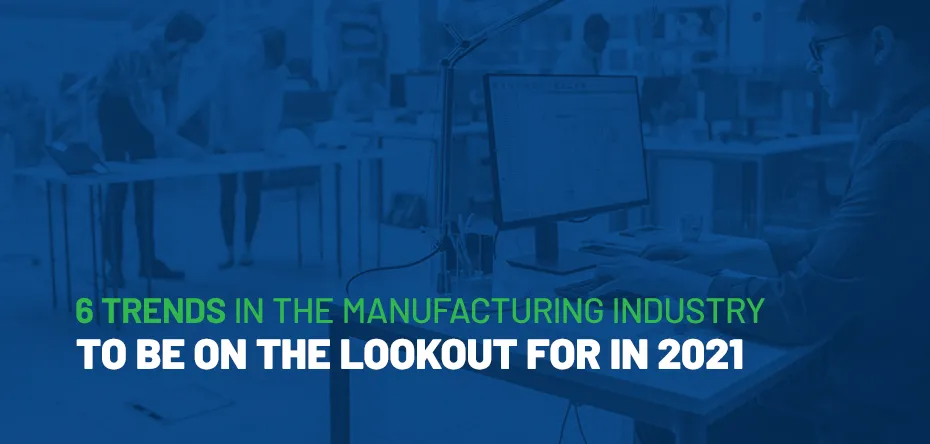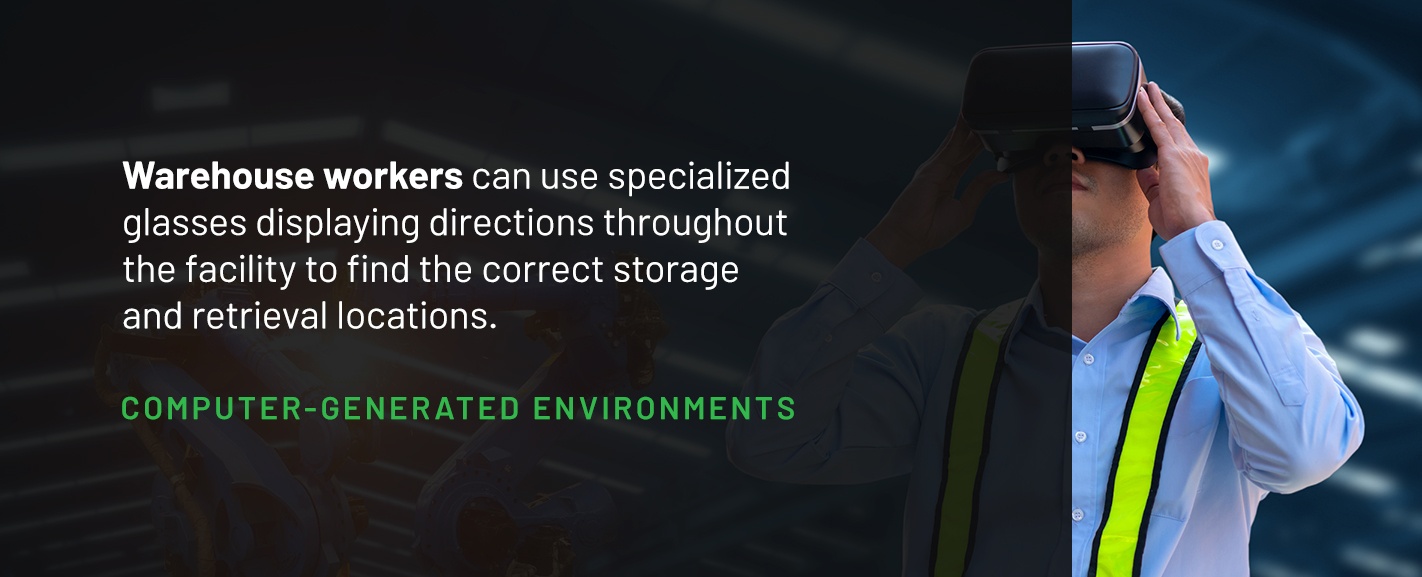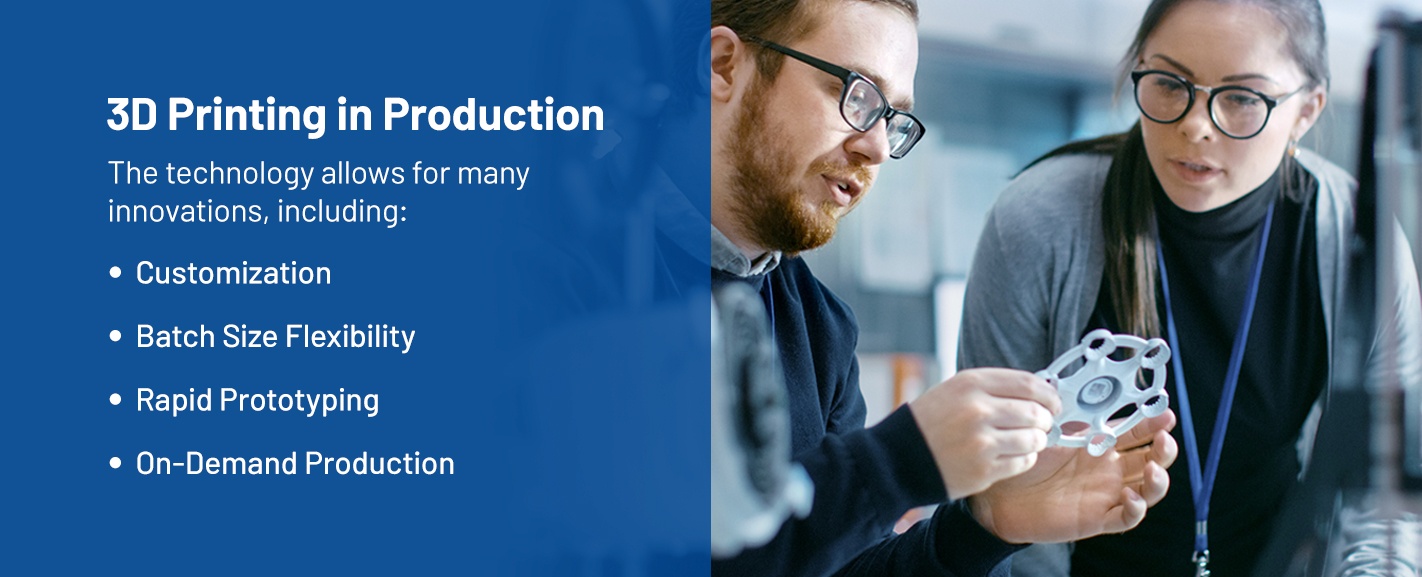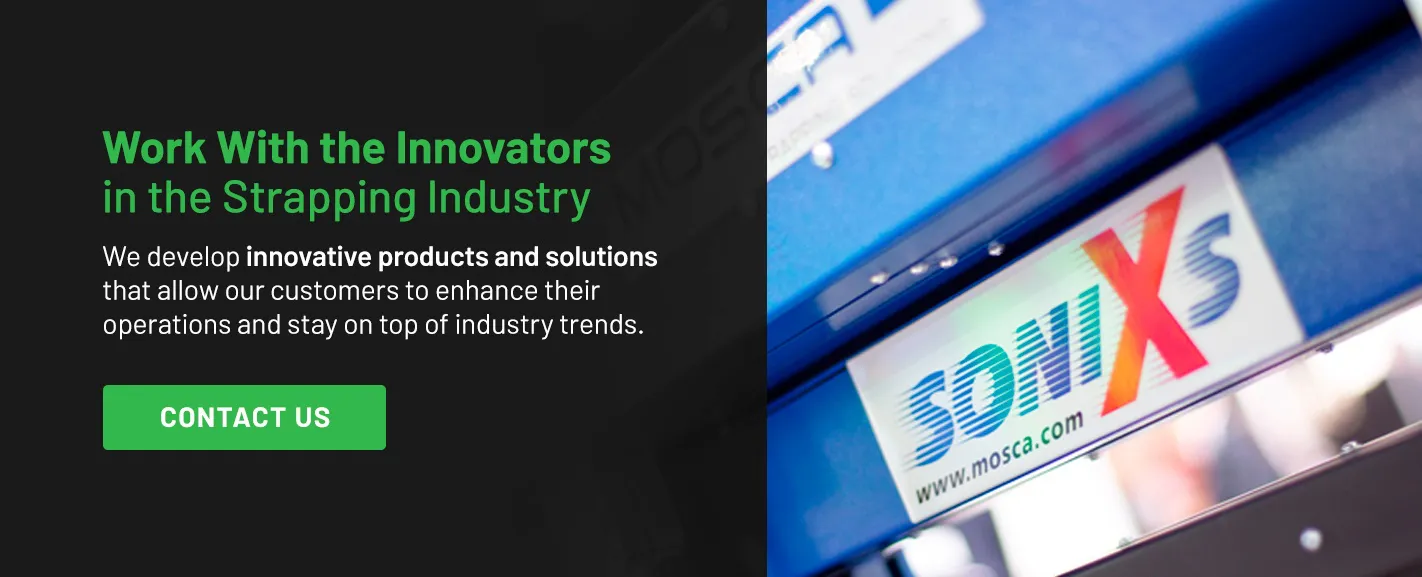6 Trends in the Manufacturing Industry to Be on the Lookout for in 2021
Manufacturing is changing in surprising ways. Some manufacturing industries are growing tremendously thanks to new technology, streamlined operations and innovative ideas. What trends are on the rise and expected to flourish in 2021? Here’s what you need to know.
1. Predictive Maintenance
Manufacturers have long seen preventive maintenance as the gold standard. It reduces downtime and saves on repair costs compared to reactive maintenance. Through the preventive model, plants can schedule maintenance rather than wait for an issue to arise. The result is less unscheduled downtime that reduces productivity.
Predictive maintenance, however, is the next generation of preventive maintenance, and a trend to look out for as industry 4.0 becomes more popular. The method optimizes your technical support in real-time, rather than through set schedules. It allows you to extend the life of your equipment and avoid more interruptions.
The technique uses statistical analysis of production data to reveal patterns and predict issues. Rather than rules of thumb, it uses evidence from your actual equipment. Sensors calibrated to set parameters trigger alerts when machines fall out of the acceptable range. Then, technicians can schedule downtime before a failure occurs. Predictive maintenance offers several competitive advantages:
- Reduced costs: Maintaining equipment as needed allows you to extend the life of your parts. Most factory equipment has a recommended number of service hours between maintenance times. If you follow those time frames, you sometimes replace parts or maintain equipment prematurely, raising maintenance costs. Through predictive maintenance, you can repair equipment right before it fails. This method maximizes your spending and promotes a lower total cost of ownership.
- Fewer failures: Even routine maintenance can’t always reveal errors waiting to happen. Inspectors who don’t have access to predictive data can miss hard-to-detect issues. Predictive maintenance is proven to increase the time between failures, so your facility can enjoy long stretches of uninterrupted productivity.
- Less scheduled downtime: Predictive analytics can provide diagnostics while the equipment is still in use. Technicians know what problems need fixing without troubleshooting. When you plan downtime for required maintenance, your repair specialists can get in and out faster. In addition, downtime due to repairs happen less frequently under the predictive model.
- Optimized parts inventory: Predictive analytics allows you to anticipate what parts you will need. Instead of stocking a full catalog of any spare part you may need, you can adopt a just-in-time approach to your equipment inventory.
While the cost to adopt predictive maintenance is higher than preventive maintenance, it produces greater cost savings over the lifetime of the equipment.
Implementing predictive maintenance requires a discussion on lead time, as well. The closer you get to failure before intervening, the more accurate future predictions will be. EAM-Mosca Corporation offers an analytics-driven predictive maintenance program on all their equipment.
2. Smart Manufacturing
The smart manufacturing trend combines automation, artificial intelligence (AI) and the Internet of Things (IoT). Integrated technology allows smart devices to sense their environments and interact with each other. The intelligent production environment unifies some of the current trends in the manufacturing industry. Predictive maintenance relies on smart sensors to predict equipment failure. Those sensors can also bring predictive philosophy to other areas of manufacturing. Data can forecast inventory demand and reveal potential quality deviations before they travel too far into production.
3D printing and computer-generated environments also rely on smart technology. An ERP system aggregates the data from all the sensors and equipment, allowing the entire organization to access it and make crucial decisions.
The rise of fifth-generation networks (5G) presents an excellent opportunity for manufacturers to implement new technology. Compared to previous generations, 5G has a higher capacity, more wireless flexibility, and lower latency. The market size for smart manufacturing is projected to reach $479.01 billion by 2023. Factories continue to add more sensors, connected tools and data collection devices to their IoT. As more automation, software, and tools become part of a plant, a faster network is crucial.
3. Computer-Generated Environments
Virtual, augmented, and extended reality have many applications for the manufacturing industry. Augmented reality (AR), in particular, enhances human abilities and speeds up operations. As opposed to virtual reality (VR), AR superimposes information onto real-world images. Warehouse workers can use specialized glasses displaying directions throughout the facility to find the correct storage and retrieval locations. Lineworkers can use a tablet device to scan a collection of parts and identify the ones needed.
The applications of Virtual Reality (VR) and AR in manufacturing are only now beginning to be realized. Here are some aspects of operations you can enhance with this emerging technology:
- Virtual workforce: In 2020, the remote workforce exploded. Traditionally, manufacturing is a hands-on field, left behind in the work-from-home trend until VR and AR stepped in. Through VR, an engineer or manager can be transported to the shop floor from almost anywhere. They can examine works in process, provide feedback in real-time, or direct workers through maintenance tasks. Further, the manufacturing industry is seeking new ways to fill its growing talent gap from aging employees. Tapping into highly-skilled labor from around the globe through VR and AR can help fill the void.
- Maintenance: AR devices can access data from predictive maintenance tools to provide real-time information on the shop floor. Technicians can quickly analyze equipment and know the last time each instrument was repaired. They can also see which machines are falling out of line with set parameters. AR can examine the inner workings of each device and highlight damaged parts for faster repairs.
- Training: VR can transform classroom learning into a hands-on experience in a safe environment. Rather than using expensive equipment for demonstrations, trainees can learn through VR headsets. They can also use AR devices to understand what’s happening inside equipment without the need to disassemble. Recruits can shadow veteran workers from a safe distance, while AR helps them see up close. As AR and VR grow in popularity for entertainment, they also have the potential to make training more engaging and memorable.
- Quality control: AR can speed up quality inspections, making it easier to identify defects. The technology can highlight parts assembled incorrectly and identify products that don’t meet standards. AI adapts to real-world information and finds problems faster than the human eye.
- Assembly: Complicated and delicate assemblies increase the chances of human error. Following precise assembly instructions is often a time- and labor-intensive task. Workers may need to switch back and forth between reading instructions and carrying out the procedure. AR glasses can present the assembly directions step-by-step in real-time. This innovation can significantly cut production time and error rates.
4. Streamlined Processes Through ERP Systems
Enterprise resource planning (ERP) systems aid an entire organization in receiving real-time information across departments. While the technology throughout a plant collects data on everything from equipment to inventory and output, anyone in the company who needs it can access it instantly. It can also feed into automation and software programs.
ERPs break up information roadblocks and reduce administrative and operational costs. By aggregating real-time data, it powers predictive maintenance and a host of other shop floor and back-office functions.
- Data accuracy: Without real-time capabilities and integrated systems, critical data can get lost in translation. When you rely on manual reporting or disparate collection tools, you have the potential for errors, duplicate data, and conflicting information. Sorting through what’s valid and what isn’t costs organizations significant time and effort. An ERP can streamline data collection and sharing, making it more accurate. Everyone in the company can access the same data.
- Speed: An ERP eases communication and information sharing between departments. For example, when the accounting team needs an accurate inventory count, they don’t need to wait until the inventory manager sends it over. Instead, the financial side can access it in real-time as easily as the inventory manager can.
- Financial analysis: To get 100% visibility into your organization’s spend, you need data from every department. With cost reduction being a key objective for most manufacturers, seeing where all your budgeting goes down to the penny is critical. Through data visualization features, you can quickly identify your greatest cost centers and optimize spending.
- Automation: Many of the tasks involved in manufacturing can be automated through the help of an ERP. For example, it can automatically reorder materials based on data on inventory levels. By automating rote tasks throughout the production process, employees can dedicate more attention to high-skill tasks.
Manufacturing-specific ERPs offer more advanced capabilities geared to your production operations. A high-quality manufacturing ERP can include features like:
- Demand forecasting and resource planning
- Warehouse management
- Quality management
- Inventory control
- Transportation logistics
5. 3D Printing in Production
Traditional manufacturing methods require subtractive material use. For example, the process might start with a sheet of metal to create a specialized metal part. Computer numerical control (CNC) machinery would then precisely cut the sheet until it was the right size and shape. Laser cutting and water jet cutting are two other common examples of processes that use subtractive manufacturing.
What happens with all the scrap metal or plastic after the final product has been revealed? In most cases, the excess material is recycled, scrapped, or repurposed. The traditional subtractive process wastes material, costing your facility money. Often, it also requires additional resources to recycle or dispose of the materials safely.
3D printing changes this. Additive manufacturing processes mold the exact shape using the precise amount of material required. Products and parts are created layer-by-layer, leaving zero material waste. The technology also allows for many innovations, including:
- Customization: 3D printing can create any design or variation on a product without the need for new processes, molds or machinery. The need for customization is prominent in luxury product manufacturing. For example, automotive manufacturers plan to3D print seat cushions shaped to the driver’s exact body contours. We expect to see this innovation on the market by mid-2021. Medical device manufacturers can also print prosthetics and dental aligners for individual patients.
- Batch Size Flexibility: Traditional manufacturing processes often require you to buy raw materials in bulk. As a result, you need minimum quantities from your customers or charge extra for partial batches. 3D printed products can be made to order, with batch sizes as small as one unit, without sacrificing any material. This benefit has particular applications to the aerospace industry, which often demands highly specialized parts in low quantities.
- Rapid Prototyping: Prototypes are crucial to the product design process. Some ideas need to be materialized so engineers can work through design snags and refine the end product. Traditional prototyping can be expensive and time-consuming. 3D printing can quickly create low-cost prototypes, allowing manufacturers and engineers to bring new ideas to market faster.
- On-Demand Production: Inventory management presents many issues for manufacturers. Traditional business models require manufacturers to produce products in advance, so they are ready to ship when a customer orders them. Manufacturers then have to dedicate property and teams to manage a warehouse. 3D printing allows companies to create products to order and on-demand, eliminating the need to store as much inventory.
6. Local Production and Distribution
Not long ago, outsourcing and offshoring were the industry norm. Now, manufacturers are moving back to domestic manufacturing. Many factors are contributing to the reshoring trend.
First, the global economy has improved, bringing with it higher production costs. It’s no longer much cheaper to produce products in the countries manufacturers flocked to decades ago. Now, headquartering operations domestically lets companies simplify their supply chains. With fuel and transportation costs on the rise, keeping plants as close as possible to end-customers is an important cost-saving strategy.
In international markets that can support cheap production, the manufacturing infrastructure is lacking. North America has the automation capabilities and infrastructure in place, turning local production into a competitive advantage.
The rise of e-commerce is also changing distribution. Once, producers shipped consumer goods in bulk to stores along set routes. Now, some manufacturers ship products to individual doorsteps. Supply chains have added a new link to accommodate for this change — e-fulfillment centers. As end-delivery requires a more extensive network for transportation, local-for-local manufacturing saves on shipping costs.
Decentralized manufacturing involves companies creating individual plants local to the markets they serve. Then, when a customer makes a new order, the products will travel a much shorter distance. This distribution model can improve shipping speeds as well as cut transportation costs.
How Your Manufacturing Plant Can Stay on Top of Industry Trends
Keeping pace with your competitors requires constant innovation and improvement. It also asks you to know where your industry is headed and make investments in the right technology and skills to follow suit. How can manufacturers like you learn what the industry trends are and respond to them? Here are some tips.
1. Follow Trade Associations and Publications
Trade groups and industry journals make it their business to help you succeed in your market. They report on news affecting manufacturers and often publish original data and reports. They also provide educational resources that can help you implement new operations. You’ll get top insights from subject matter experts and valuable tools to help you act on that knowledge.
2. Watch Your Customers and Your Competitors
Meeting customer demands is where innovations come into existence. Talking to your customers can reveal their pain points and what problems the industry has yet to resolve. Further, when your competitors launch new products, techniques, or operational strategies, take notice. While differentiation is always the goal, some of your competitors’ technology and tactics will soon be industry practice.
3. Invest in the Right Equipment
Innovation can get bogged down by time-consuming practices or an inefficient production schedule. Every piece of equipment in your factory needs to offer faster speeds and easy maintenance. EAM-Mosca Corporation’s strapping and end of line packaging solutions let your team focus on those high-skilled tasks that can bring your company to the top of your field. Mosca’s strapping systems are high-performing and value-driven, allowing products to be strapped with less manual labor. These systems also contribute to better use of raw materials along with lower energy and equipment maintenance costs.
Work With the Innovators in the Strapping Industry
EAM-Mosca is a leader in the industry, developing innovative products and solutions that allow customers to enhance their operations and generate improved profitability. If you’re interested in upgrading your strapping system, consider investing in SoniXs® Ultrasonic Sealing technology. Ultrasonic sealing offers more consistent, higher quality seals compared to other sealing technologies utilized for PET and PP strapping. The system also uses less electricity, as applied heat or friction is not required to create a seal.
Contact us to learn about all the benefits of our technology and request an estimate.






